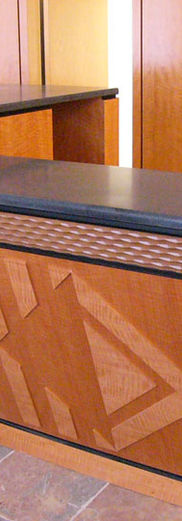
JACK TRAVIS
Jack Travis FAIA ARCHITECT
African American AIA Fellow
SAY IT LOUD - NOW Exhibitor
SAY IT LOUD - Washington DC Exhibitor
New York Based Designer
What is your proudest professional accomplishment or achievement?
Completing the first book to showcase the work of Black Architects here in the United States currently practicing as of 1992. I was most surprised and please to learn that my efforts was the first – then I was saddened by that very same fact Been sober ever since and the mission is laser focused
and sure.
JACK TRAVIS
Bio:
Jack Travis established his namesake design studio in June 1985. Jack Travis encourages investigation into Black history and culture where appropriate in his work and includes forms, motifs, materials and colors that reflect this heritage. Travis has evolved ten principles for Black cultural Design investigation towards that aim. Travel throughout the United States, Europe, the Caribbean to West and South African countries has given Mr. Travis a most unique focus. Through his work, he continues to make a distinctive and definitive enrichment to the existing American design vocabulary. In recent years, Travis has broadened his interests beyond cultural content strategies to sustainable in environmental design methodologies, alternative educational practices such as a community design studio and the entrance of more students of color into academia and the profession. Jack Travis has taught at Parsons School of Design in the Continuing Education Department and is currently an adjunct professor of interior design at Pratt Institute and at the Fashion Institute of Technology in New York City. The Great designer, Jack Travis’ career of 25 years has evolved a triumvirate approach of educating students, practitioners and citizens nationally and internationally to the legacy of Blacks in Architecture and the defining of a Black design aesthetic.
Jack Travis: The Global Africa Project Interview - 2010
2 Min 48 Sec
https://www.youtube.com/watch?v=ZUsDHkHIYMI
CNN Style with Elsa Klensch - 1995
3 Min 10 Sec
https://www.youtube.com/watch?v=0E6Ta0ymoKQ
J Travis Inspired: Africa, WPA Art and a Unique Hospital Design - 2013
1 Hr 32 Min 48 Sec
https://www.youtube.com/watch?v=orbRNNebPE4
J Travis AIA NY Interview - Next Gen Arch: Equity, Diversity, and Inclusion Initiative
From 10:58 – 15:15
NOMA at 40 - OUR TIME: PAST, PRESENT, FUTURE. REFLECTIONS AND
OBSERVATIONS OF THE ARCHITECTURAL INDUSTRY: PAST, PRESENT, AND FUTURE - 2012
Page 19
https://noma.net/wp-content/uploads/2019/02/Fall2012NOMAMag_FINAL.pdf
Conversations with the Diaspora: A Plenary Discussion - 7.31.15
3 Hrs 11 Min 27 Sec
World Interiors Day Webinar with Jack Travis
1 Hr 36 Min 50 Sec
https://www.youtube.com/watch?time_continue=1&v=USQwwoPC3pY&feature=emb_logo
Archi Afrika E Lecture Series – Jack Travis
I Hr 21 Min 58 Sec
Jack Travis, "Fringe Benefits: Recent Work Outside Looking In"
1 Hr 05 Min 30 Sec
https://www.youtube.com/watch?v=U05ADlCs0Lo
Object:
Object Five - Alternative career, volunteer work with organizations not directly connected with the built environment, or service to society
Year of Elevation:
2004
How did you first learn about architecture and when did you decide that built environment profession was an area of interest for you?
Ten years old in fifth grade I wrote one of my first essays on how badly our school was designed for children attending it It was designed in the Brutalist style of which at that time of course I had no idea of I simply thought that the building was not kid friendly
What do you do?
I am principal in my small firm of one person with an interior design assistant and I usually get a student or two to assist e when I am busy I am also an adjunct professor teaching in four interior design programs here in NYC. They are The Fashion Institute of Technology (FIT), Pratt Institute, School of Visual Arts (SVA) and The New York School of Interior Design (NYSID)
What excites you in the work you do?
The discovery of something bold or new particularly when it pertains to a Black or African based initiative in environmental design Black culture is well underrepresented in our profession. My work looks at evolving a Black aesthetic People often ask me what is that – or - what does it look like I tell that that I may not know exactly what it looks like, but I do know what it doesn’t look like! And that is anything that has to do with a strong non African ideal of base I think Black architects have to sever ourselves greatly from the seduction of the current academy if we are ever to produce a ew direction and focus for architecture – one that comes from our own sensibilities and not one that is well defined and demands that all others address its importance.
What is your proudest professional accomplishment or achievement?
Completing the first book to showcase the work of Black Architects here in the United States currently practicing as of 1992. I was most surprised and please to learn that my efforts was the first – then I was saddened by that very same fact Been sober ever since and the mission is laser focused and sure.
Featured Project Name:
Harlem Hospital
Featured Project Location:
New York, NY
Featured Project Completion Date:
2012
Role in Featured Project:
Architect
Featured Project Description:
This patient-centered hospital building establishes a strong connection to its Harlem community by celebrating a historically significant mural at a civic scale. Depicting scenes from the African diaspora, the artwork was digitally printed on the facade using ceramic ink. It soars 65 ft high and spans an entire city block. As the new centerpiece of the Harlem Hospital Center, the Mural Pavilion unifies previously disconnected hospital facilities spread across seven buildings and two city blocks.
Photography Credit:
HOK, Jack Travis












